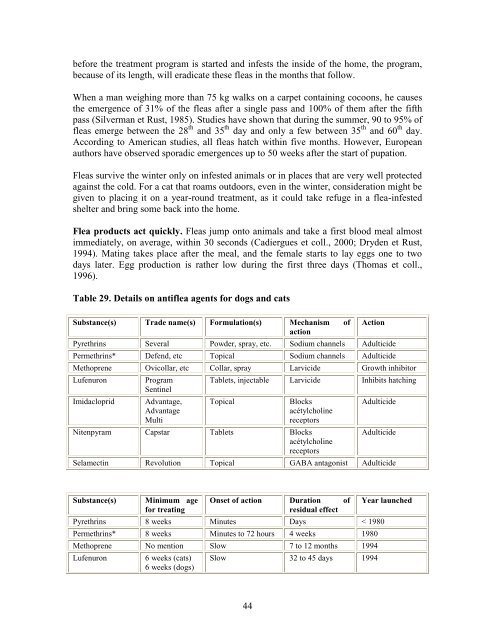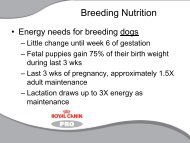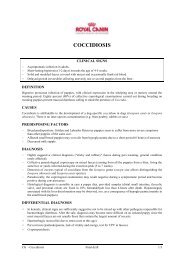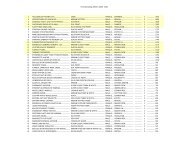Guide to Preventing Parasites.pdf - Royal Canin Canada
Guide to Preventing Parasites.pdf - Royal Canin Canada
Guide to Preventing Parasites.pdf - Royal Canin Canada
You also want an ePaper? Increase the reach of your titles
YUMPU automatically turns print PDFs into web optimized ePapers that Google loves.
efore the treatment program is started and infests the inside of the home, the program,<br />
because of its length, will eradicate these fleas in the months that follow.<br />
When a man weighing more than 75 kg walks on a carpet containing cocoons, he causes<br />
the emergence of 31% of the fleas after a single pass and 100% of them after the fifth<br />
pass (Silverman et Rust, 1985). Studies have shown that during the summer, 90 <strong>to</strong> 95% of<br />
fleas emerge between the 28 th and 35 th day and only a few between 35 th and 60 th day.<br />
According <strong>to</strong> American studies, all fleas hatch within five months. However, European<br />
authors have observed sporadic emergences up <strong>to</strong> 50 weeks after the start of pupation.<br />
Fleas survive the winter only on infested animals or in places that are very well protected<br />
against the cold. For a cat that roams outdoors, even in the winter, consideration might be<br />
given <strong>to</strong> placing it on a year-round treatment, as it could take refuge in a flea-infested<br />
shelter and bring some back in<strong>to</strong> the home.<br />
Flea products act quickly. Fleas jump on<strong>to</strong> animals and take a first blood meal almost<br />
immediately, on average, within 30 seconds (Cadiergues et coll., 2000; Dryden et Rust,<br />
1994). Mating takes place after the meal, and the female starts <strong>to</strong> lay eggs one <strong>to</strong> two<br />
days later. Egg production is rather low during the first three days (Thomas et coll.,<br />
1996).<br />
Table 29. Details on antiflea agents for dogs and cats<br />
Substance(s) Trade name(s) Formulation(s) Mechanism of<br />
action<br />
44<br />
Action<br />
Pyrethrins Several Powder, spray, etc. Sodium channels Adulticide<br />
Permethrins* Defend, etc Topical Sodium channels Adulticide<br />
Methoprene Ovicollar, etc Collar, spray Larvicide Growth inhibi<strong>to</strong>r<br />
Lufenuron Program<br />
Sentinel<br />
Imidacloprid Advantage,<br />
Advantage<br />
Multi<br />
Tablets, injectable Larvicide Inhibits hatching<br />
Topical Blocks<br />
acétylcholine<br />
recep<strong>to</strong>rs<br />
Nitenpyram Capstar Tablets Blocks<br />
acétylcholine<br />
recep<strong>to</strong>rs<br />
Adulticide<br />
Adulticide<br />
Selamectin Revolution Topical GABA antagonist Adulticide<br />
Substance(s) Minimum age<br />
for treating<br />
Onset of action Duration of<br />
residual effect<br />
Pyrethrins 8 weeks Minutes Days < 1980<br />
Permethrins* 8 weeks Minutes <strong>to</strong> 72 hours 4 weeks 1980<br />
Methoprene No mention Slow 7 <strong>to</strong> 12 months 1994<br />
Lufenuron 6 weeks (cats)<br />
6 weeks (dogs)<br />
Slow 32 <strong>to</strong> 45 days 1994<br />
Year launched







